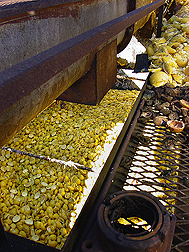Ethanol Feedstock From Citrus Peel Waste
|
|
With the recent wild fluctuations in gasoline prices, there’s renewed interest in finding a cheaper way to fill up the gas tank.
In 1992, Karel Grohmann, then research leader of the ARS Subtropical Products Laboratory in Winter Haven, Florida, began research on converting citrus peel waste into fuel ethanol. Citrus waste materials are rich in pectin, cellulose, and hemicellulosic polysaccharides, which can be hydrolyzed into sugars and fermented into alcohol.
In Florida alone, citrus processing yields about 5 million tons of wet waste annually, or 1.2 million tons of dry waste. Most dried peel residue is marketed as low-value cattle feed.
Grohmann’s research was eventually discontinued because the enzymes needed to fuel the process were expensive, and gas, at the time, was relatively cheap. But an economic flip-flop occurred over the past decade, thanks to a rise in gas prices and more economical production of the enzymes. Another boost has been a trend toward prohibiting use of the environmentally unfriendly MTBE (methyl tertiary-butyl ether) as an oxygen additive to gas. After MTBE, ethanol is the next best choice.
In 2004, Bill Widmer, an ARS chemist at Winter Haven, picked up where Grohmann left off. With the help of a cooperative research and development agreement partner—Renewable Spirits, LLC, of Delray Beach, Florida, Widmer and his scientific team first modified the process to cut the amount of enzyme required to convert citrus-waste carbohydrates to sugars and ethanol. Then they scaled it up to where the process shows economic promise for large-volume production.
The 1-quart and 1-gallon laboratory processes developed by Grohmann were modified to work at 10-gallon, 100-gallon, and 1,000-gallon batch levels. Helping to make the process economical in the short term are recovery of limonene and use of the residue (which contains significantly more protein than the original citrus waste material) after ethanol conversion as cattle feed. The ARS process can double the value of byproducts obtained from citrus waste. And with more research, material from the residue left after limonene removal and ethanol production could be turned into other industrial products, such as building-material additives and ion-exchange resins for wastewater cleanup. These uses could double or triple the value of the waste stream yet again.
The current goal is to build a 10,000-gallon operation during this year. Widmer thinks that, with further research, Florida’s citrus peel waste could yield up to 80 million gallons of ethanol per year. That amount won’t meet the nation’s demand, but it could meet a local demand for oxygenating fuel additives in central Florida. “This could be a great revenue source for citrus growers,” Widmer says.—By Alfredo Flores, Agricultural Research Service Information Staff.
This research is part of Quality and Utilization of Agricultural Products, an ARS National Program (#306) described on the World Wide Web at www.nps.ars.usda.gov.
Wilbur W. (Bill) Widmer is with the USDA-ARS Citrus and Subtropical Products Research Laboratory, 600 Avenue S, N.W., Winter Haven, FL 33881; phone (863) 293-4133, fax (863) 299-8678.
"Ethanol Feedstock From Citrus Peel Waste" was published in the April 2006 issue of Agricultural Research magazine.







